I’ve always questioned the value of trekking poles. To be honest, I’ve always thought of them as a somewhat goofy-looking fashion statement. Last year I began to reconsider, though. With a big increase in hiking and especially hiking over elevation, I started looking for something to ease my knee pain on hikes with lots of downhill. So, I gave them a try, and after ~40 miles on trail with them, they’re now essential kit for me. Bottom line up front: If you’re a banged-up, high-mileage model like me – and don’t want to give up hiking – you might benefit significantly from hiking with trekking poles.
This article contains affiliate links.
Trekking poles are basically dual walking sticks. While a single pole (or stick) will give you some stability, having two gives you a benefit that is greater than the sum of its parts. The upper body is enable to share in the work of hiking. Let’s look at some of the benefits of trekking poles.
Advantage: Reduced Impact on Declining Terrain
This is the biggest benefit by far. I woke up thinking about this today because we did a pretty good hike yesterday (8 miles, 1,500′ elevation gain). In spite of that, my knees aren’t screaming this morning. In fact, I was able to walk down the stairs, change the laundry, and come back up without too much trouble. That’s not typical for me after a hike with that much up and down. How do trekking poles take this weight off your knees? They do so by recruiting your upper body. The trekking poles lead down the hill. You load some of your weight onto them before taking the next step. This places some of the weight on your arms, and reduces both the weight held on the rear knee, and the weight absorbed by the forward knee. It doesn’t sound like it would do much but the difference is massive.
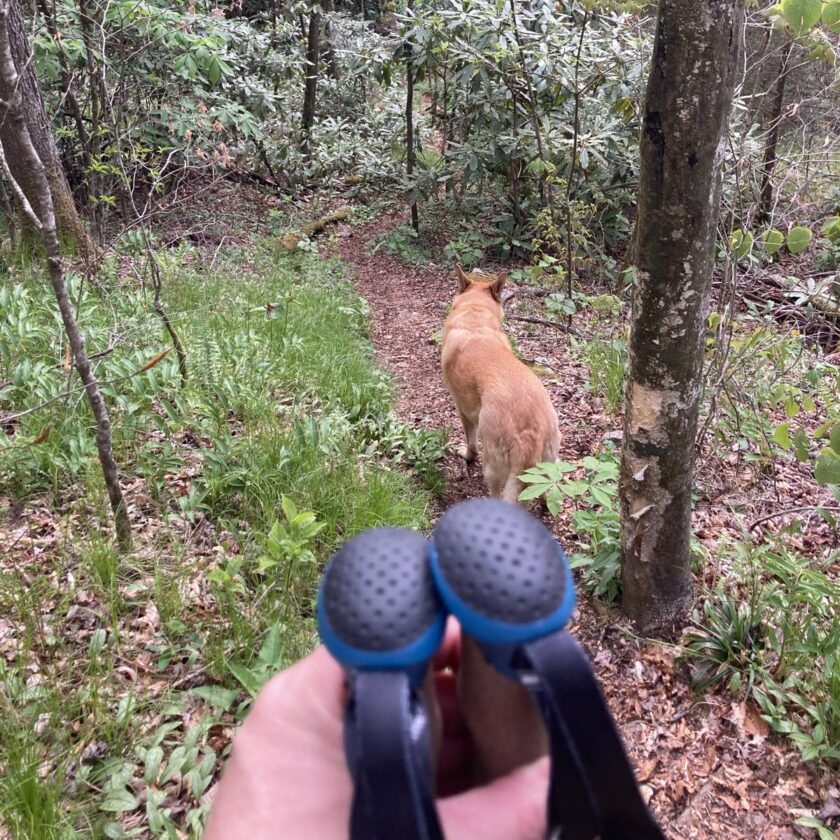
You may be wondering, “why not just carry one? Why do you need both?” The answer essentially boils down to symmetry and body mechanics. With two poles you can use both your arms to provide a somewhat stable platform that can absorb massively more weight than one, ill-balanced pole alone. While you can walk with one if you want, you’ll want two to get the reduced impact and improved mobility. Trekking poles also provide a slight benefit on uphill terrain, though probably not as much. Using trekking poles can help in “pulling” yourself up a hill. This can reduce fatigue by – again – getting your upper body involved in the hike.
Though help with uphills is a pretty good benefit, my main reason continues to be the impact reduction on downhill terrain. Taking the weight off my knees has been worth the cost, inconvenience, and silly look of the trekking poles, but that’s not all. Let’s take a look at a couple of the other benefits of these high-speed, low-drag sticks.
Advantage: Stability in Unstable Terrain
The second, almost immediately recognizable benefit of trekking poles is the addition stability they provide in unstable terrain. This includes loose, rocky terrain, river/creek/stream crossings, and snowy/icy terrain. I’ve used my trekking poles in all three, and probably the most visceral benefit of this nature comes when crossing streams.
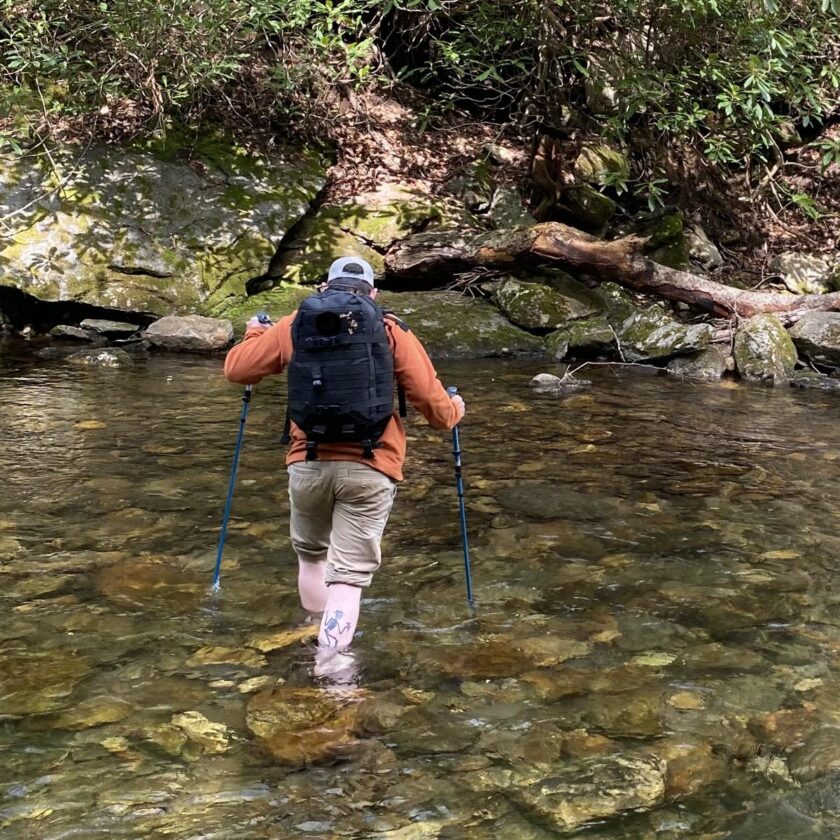
Here’s a good example: in March we did a hike that started on a 20-degree morning. It was freezing out. Within the first mile of our hike we had to cross a creek that was about 100-feet wide. There were rocks that you could essentially walk across on, but like a lot of rocks some were slick, some weren’t super stable, and some offered a less-than-ideal foothold. To make matters worse it was so cold that any water on your feet (from stepping on some rocks that were shallowly submerged) was transferred to the next rock you stepped on and almost immediately became ice. It was a pretty tricky crossing and not one that we wanted to turn back on, lest it cancel our whole hike.
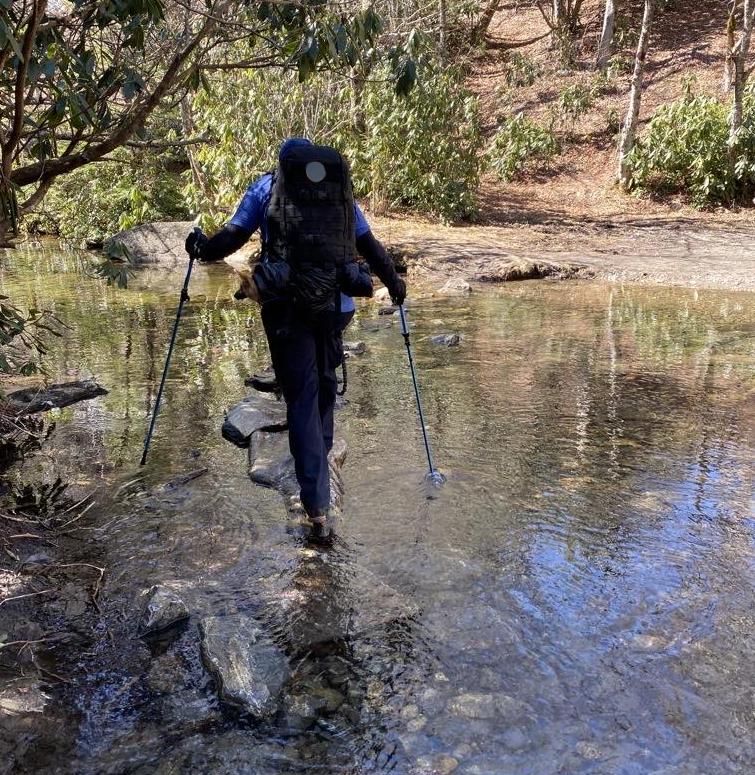
Thankfully we had trekking poles. The poles provide you with something you don’t naturally have: three points-of-contact at any given time. This made the creek crossing a breeze. Not only does it let you cross, it also lets you judge depth accurately and test footholds for traction and stability. The poles were such a boon on this hike both for the creek, and the ice along the rest of the trail.
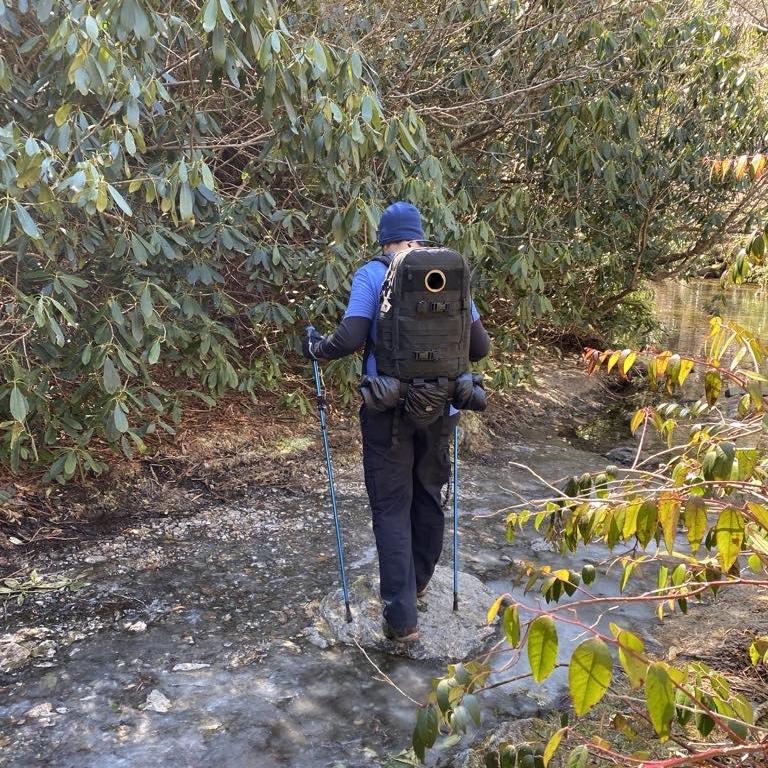
Emergency Use
As you guys know I’m always thinking about on-trail emergencies and how to deal with them. One of the most worrying types of injury to me is the orthopedic injury to a lower limb. A simple sprained ankle might keep someone from being able to walk out and require them to activate emergency mechanisms for assistance.
I don’t want to be that guy for many reasons, the least of which is my ego. I don’t want to have to sit and wait for several hours in winter when that time could easily result in a case of hypothermia. I don’t want to put fellow SAR team members at risk, and I don’t want them in the woods looking for me should someone else need them. Generally, I want to walk myself out if possible.This ability to redistribute weight may be extremely useful in the event of an orthopedic injury. Rather than having to sit down and simply wait for help, trekking poles may allow someone even with a broken ankle to walk out. A trekking pole could be useful as a splint, and in the worst case, I wouldn’t turn down a pair of poles if I were making a makeshift litter for someone else.
Trekking poles also give you a sort of improvised weapon that is immediately at hand. Though it wouldn’t be my first choice against, well, just about anything, it’s pretty decent as a standoff device. Walking sticks are reportedly pretty effective against at least some dogs. Recently I had the opportunity to nudge a snake off the trail, letting him go his way as we went ours. If the sticks don’t work I can always go to something stronger, but it is a nice, non-lethal tool that is already in your hand should you need it.
Disadvantages of Hiking with Trekking Poles
Unfortunately it’s not all good news. Like most things there’s a trade-off to be made. There are a few disadvantages to hiking with trekking poles. Let’s take a look at ’em.
Disadvantage: Full Hands
First, your hands are always full. This can be a bit of an inconvenience when reaching for your phone to take a picture, zip a zipper, or pull your hat down. As I said, this is more of an inconvenience than anything, but it is notable. To ease this a bit, I avoid putting the wrist straps on unless we are in very rugged terrain. This lets me much more easily set a pole down or transfer it hand-to-hand. The odds are pretty low that I would drop a pole on flat-ish terrain, and if I do the consequences are low (simply pick it up). If we’re moving around a river, over a boulder field, or some other place where dropping the pole would result in its loss, I use the wrist straps that are built-in to my trekking poles.
And this is really a thing. The Sunday before this article published we did a hike with significant elevation change (around 2,400′ of downhill in this case). At about the halfway mark I stopped at a point in the trail where the drop-off was fairly sheer. I’m not exactly sure what happened but the pole in my right hand dropped and ended up about 10′ below me, and pretty much straight down. So, I had to climb down, then find a way back up to retrieve the pole that probably should have been strapped to my wrist. That was definitely a case of poor risk estimation (the risk of dropping a trekking pole vs. the risk of needing to drop one quickly).
On the other hand…as my friend Jim pointed out you can injure your wrist if you fall and your wrists are inside the straps.
Disadvantages: Weight & Expense
Trekking poles add weight. If you’re an ultra-lighter (or a just a weight-conscious “regular” hiker) they add considerable weight. There are ultralight poles that only add a few ounces, but generally the lighter you go the more expensive they are. The ultralight trekking poles rely on light weight as their primary selling point, and there’s usually some other tradeoff somewhere.
Trekking poles cost money. Some of the really inexpensive trekking poles on Amazon get exceptionally good ratings. I opted to go with a brand I know from various other products I’ve used (including their lumbar pack I reviewed earlier this year): Mountainsmith. They weren’t the most expensive trekking poles by a long shot, but they weren’t inexpensive, either. You’ll spend a few bucks either way. If you’re not sure if you will like them, you might consider buying them at REI like I did. This gives you one full year to return them if you don’t like them, though you will pay a retail mark-up.
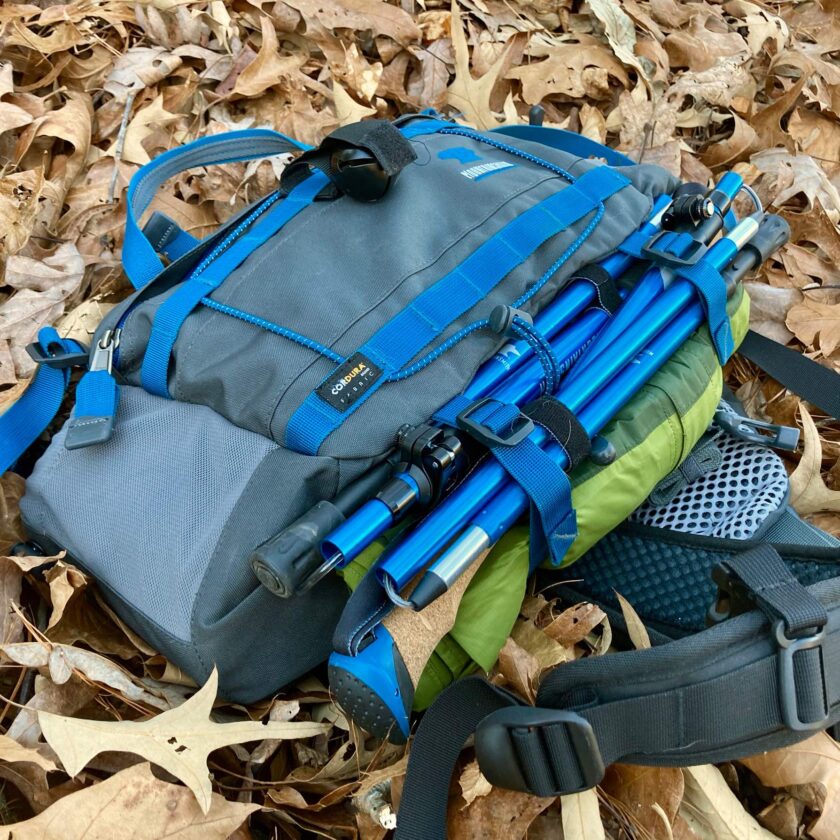
Critical Features of Trekking Poles
If this article has convinced you to take a look at trekking poles, I can tell you what I got and what I like about them. My trekking poles are the Mountainsmith Halite 7075. So far I am very happy with them. They’re relatively inexpensive and have met all of my needs amply.
Adjustability: This one is non-negotiable. Your trekking poles should absolutely be adjustable. Even if they’re sized perfectly for you on flat terrain you’ll want to shorten them a bit for uphill travel, and lengthen them for downhills. Generally your trekking poles should be adjusted so that your forearms are about parallel to the ground. If you find a set that is borderline in length, opt for a pair that will be just a bit on the long side; better too long than too short.
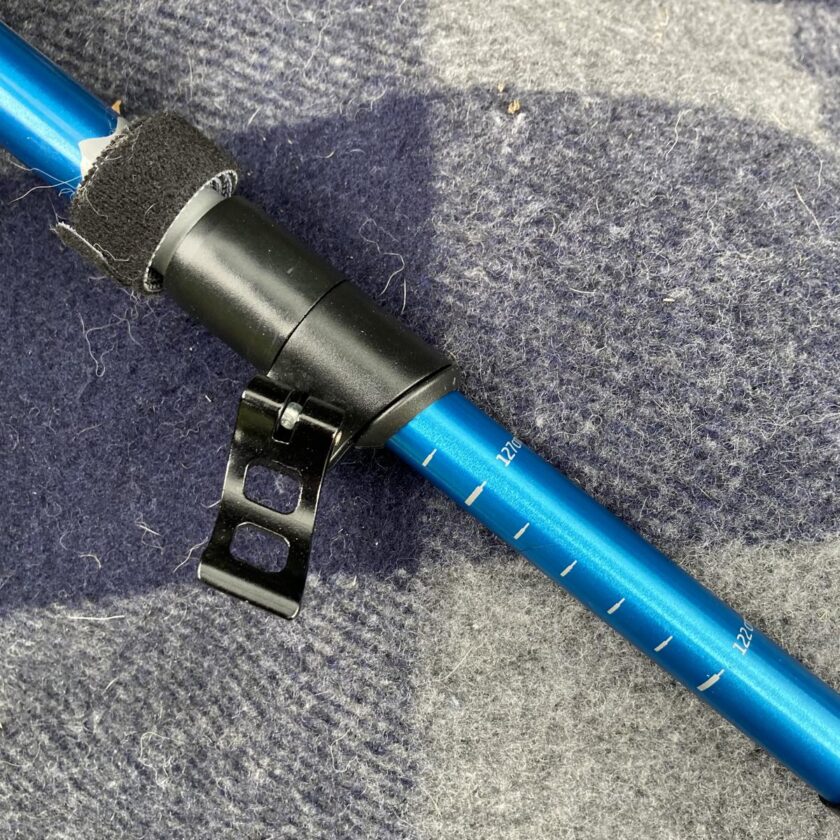
Your trekking poles should also adjust via a clamp rather than a screw mechanism. The screw-type tightening mechanism is known for failing to tighten once it gets a little grit in it. I know that from my photography days, and a lot of the reviews I found online reported that little has changed. A clamp like the one shown above won’t lose its tightness. If it does, you can adjust the clamp via a finger-tightening screw. I’m very happy with this.
Cork handles: I’ve read a lot of bad reviews of rubber or neoprene handles. Apparently they can rub blisters on your hands or otherwise get really uncomfortable. I read this before I bought trekking poles and I’m glad I did; otherwise I think I might have shied away from cork. I’ve yet to have the first issue with the cork handles and they actually feel really good.
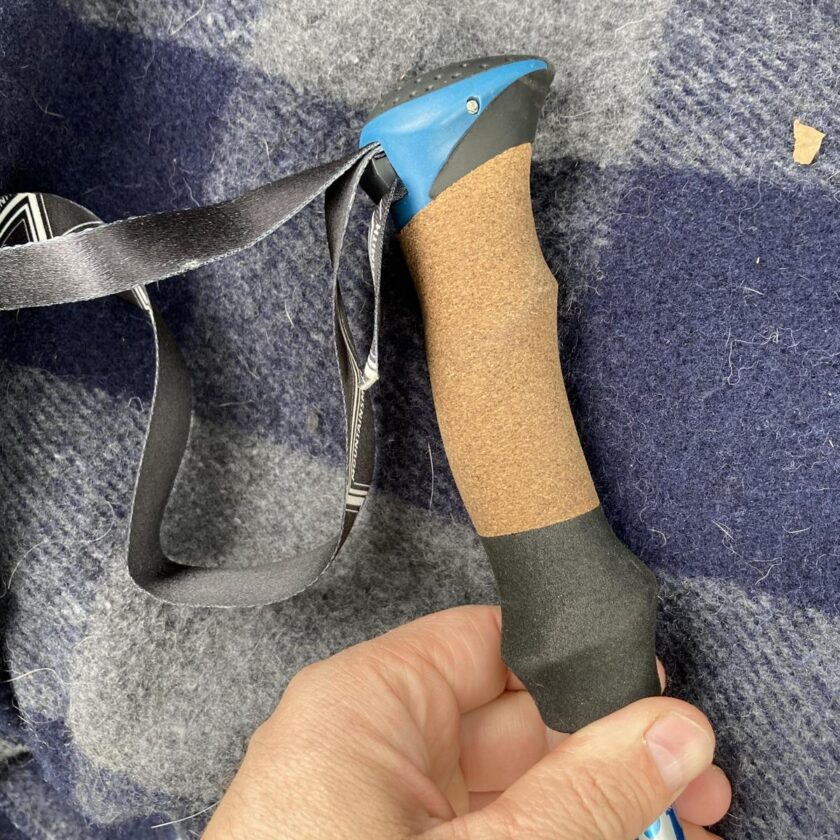
Break-down size: I’ll be honest, this wasn’t something I cared about at all. Until I used these poles a few times. Being able to break these guys down to a very short length (16″) means they are short enough to strap onto the bottom of a pack if I don’t feel like carrying them. They fit easily in the car and take up almost no space. Extremely small collapsed length also makes both the weight and the price jump; you can get cheaper poles but most of them telescope rather than fold, and folding poles are usually heavier.
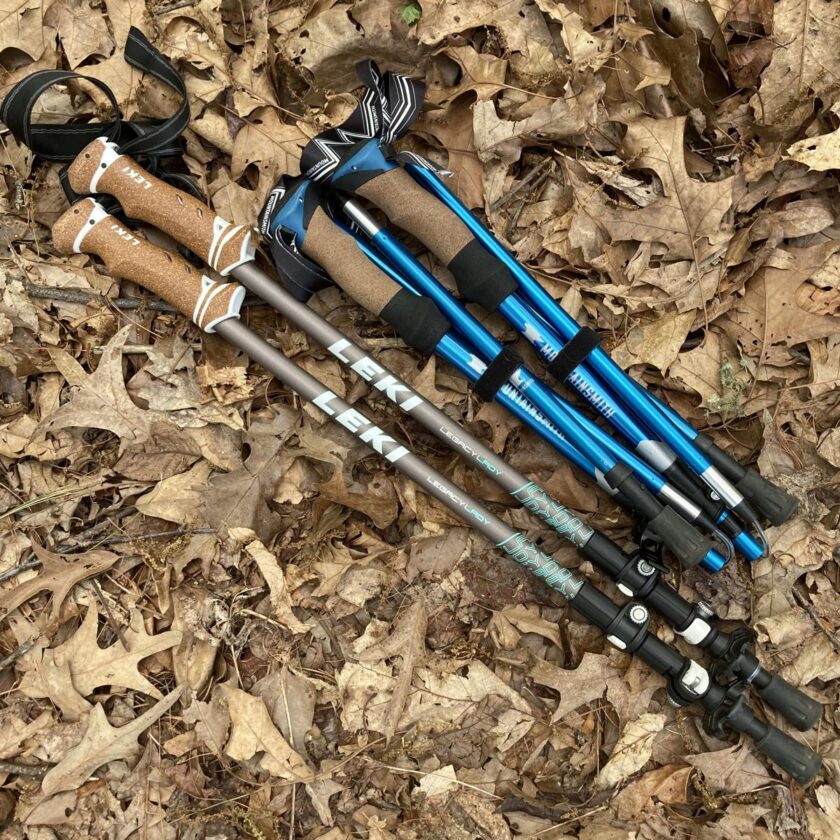
Closing Thoughts on Hiking with Trekking Poles
Trekking poles have been such a boon to comfortable hiking that I really felt like I needed to share this. Like I said, I’ve always thought people walking with fancy, $200 sticks were either old or they had more money than sense. Or both. But I’ve come to understand things differently (or maybe not, I guess I’m now officially “old”). Letting go of my dumb prejudices and trying these things was the best thing that’s happened to me in a long time. Hiking is and always has been a big part of my lifestyle and I don’t want to let that go. Thanks to trekking poles I can do longer hikes, more difficult hikes, and hike more often.
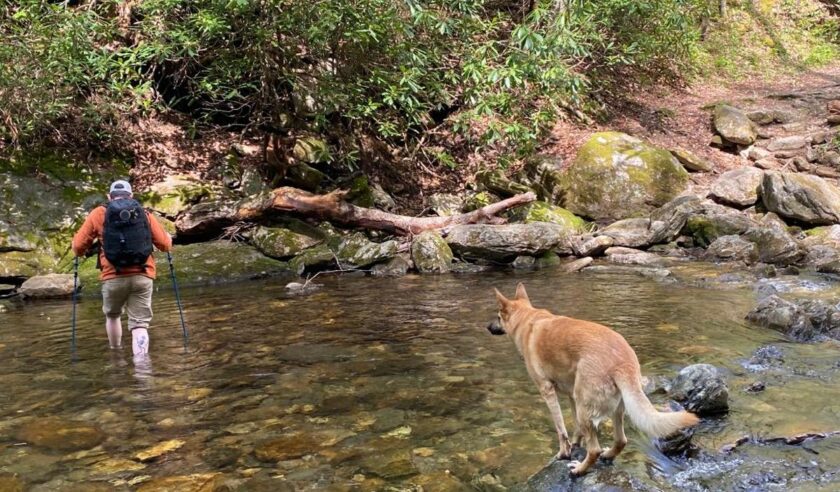






1 thought on “Hiking with Trekking Poles”
Comments are closed.